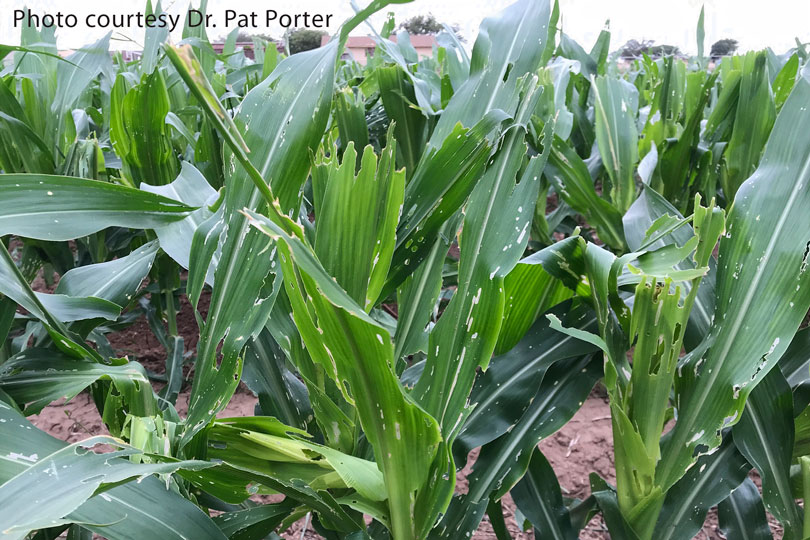By Jessica Domel
Multimedia Reporter
Fall armyworms could be a problem for some Texas corn and grain sorghum growers this year.
Last week, 707 fall armyworms were captured in Lubbock. That’s nearly 6.5 times the average for this time of year.
The problem isn’t isolated to Lubbock, according to Dr. David Kerns, professor at Texas A&M University and statewide Integrated Pest Management (IPM) coordinator.
Entomologists are seeing increased armyworm activity across the state.
“We’re seeing a lot of bollworms, too,” Kerns said in an interview with the Texas Farm Bureau (TFB) Radio Network. “Moths right now, in general, are fairly high.”
In terms of fall armyworms, there are two different strains—grain and corn.
“It’s the corn strain that we’ll see whorl feeding in corn, and we’ll see it in sorghum feeding in the whorls,” Kerns said. “It can also get in cotton.”
The grass strain tends to be more of a pasture pest and can be found feeding on Bermuda grass and hay.
“It tends to come in a little bit later,” Kerns said.
Most of the grain sorghum and corn in Texas is already past the point where there are higher incidences of fall armyworms, except the Panhandle and South Plains.
“It acts differently there, too,” Kerns said. “They tend to get a lot more fall armyworms feeding in the ears than we do in the rest of the state.”
Unfortunately, there’s not a lot farmers can do once there are fall armyworms in their crop.
“In corn, the BT (biotechnology) event for whorl feeders usually does a really good job. They’re not usually something that we have to swell on much,” Kerns said. “Once they’re feeding in the ears, there’s nothing you can do about those either. It’s kind of like an earworm. It’s just going to be there.”
The VIP trait in crops is highly effective on fall armyworms.
The older traited crops appear to be less effective.
“There’s really nothing you can do for them as far as whorl feeders. Even if you’ve got a lot of corn or sorghum where you are seeing whorl feeding fall armyworms, they’ve very difficult to control in the whorl,” Kerns said. “Even with your best products, things like Prevathon sprayed within the whorl of the plant, you can expect maybe 80 percent control at best, and that’s with a high rate.”
Often, the cost to control fall armyworms doesn’t justify the yield loss that might be associated with them—particularly in grain sorghum.
“Most of the time, it will recuperate from it,” Kerns said. “You might see a yield loss, but it’s usually not really significant.”
It’s unclear what’s causing the high number of fall armyworms right now, other than it is the right time of year.
Near Lubbock, it’s likely the fall armyworms traveled from downstate as they don’t normally overwinter in the High Plains.
Crops in the Panhandle are planted a few weeks behind those in other parts of the state, so the pests affect the plants differently, according to AgriLife Extension Entomologist Dr. Pat Porter.
“Downstate they plant earlier, and the crops grow faster. Up here, we’re in the whorl stage for corn and sorghum, so this fall armyworm goes to the whorl stage and eats ear tissue. It gouges big chunks out of it,” Porter said.
That process sets crops back in their growth cycle. If more than 30 percent of the tissue is removed, farmers need to start protecting the crop with insecticides.
The majority of corn in the Panhandle is biotech, so it’s fairly protected from whorl stage damage, but non-GMO corn is susceptible to it.
“Some of those fields may be at the point where they need to be treated, but fortunately, there are not very many non-GMO fields here,” Porter said.
Fall armyworms get worse as the year goes on, according to Porter. So, Extension specialists tell farmers if they plan to plant corn relatively early, they could plant non-GMO corn and potentially save a lot of money on seed.
If they’re planting on time or mid to late season, a biotech seed will likely pay off, because the fall armyworms come back during ear stage.
“If a grower has non-GMO corn, there are one or two insecticides that are quite effective on fall armyworms, but the trick is you have a four

